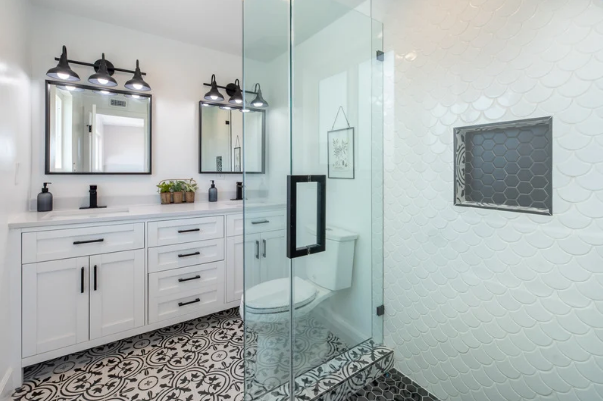Waterproof flooring is ideal for bathroom designs. When renovating your bathroom, selecting the right flooring is one of the most crucial decisions. Not only does it need to complement the aesthetics of your space, but it also needs to withstand the unique challenges a bathroom presents – primarily, moisture.
Choosing the perfect waterproof flooring for your bathroom can be daunting, but with the right guidance, it’s a task you can approach with confidence. In this guide, we’ll explore the options available, discuss their benefits and limitations, and provide you with all the information you need to make an informed decision.
Amidst these considerations, it’s also worth exploring DIY bathroom flooring options, which can be a cost-effective and satisfying project for those who enjoy hands-on home improvements.
2 Sets of Facts to Help You Select Waterproof Flooring

Understanding Waterproof Flooring Materials
Waterproof Vinyl Flooring
Vinyl flooring has come a long way in recent years, with waterproof flooring options now leading the charge in bathroom flooring solutions. Waterproof vinyl is known for its resilience against water, making it an ideal choice for bathrooms. It’s available in various designs, including those that mimic more expensive materials like hardwood or stone, offering a luxurious look at a fraction of the cost.
Ceramic and Porcelain Tiles
Tiles have been a traditional choice for bathroom waterproof flooring for years, and for good reason. Ceramic and porcelain tiles are inherently waterproof and durable and are available in various styles and colors. Porcelain tiles, in particular, are known for their exceptional water resistance and strength, making them an excellent choice for high-moisture areas like bathrooms.
Natural Stone Tiles
Natural stone tiles are a fantastic option for those looking for a touch of elegance and luxury. While more expensive, materials such as marble, granite, and slate offer unparalleled beauty and uniqueness. However, it’s important to note that some stone tiles are porous and may require sealing to enhance their waterproof properties.
Laminate Flooring
Modern laminate flooring can also be a suitable option for bathrooms, provided it is specifically designed for high-moisture areas. Waterproof laminate flooring is constructed to resist water penetration, making it a feasible, albeit less common, choice for bathroom flooring.
Factors to Consider When Choosing Bathroom Flooring
Style and Aesthetics
Your bathroom’s flooring should align with the space’s overall design and color scheme. Consider the size of your bathroom and the amount of natural light it receives. Light-colored flooring can make a small bathroom feel more spacious, while darker tones can add warmth and depth to a larger room.
Safety and Comfort
Safety is crucial, especially in a bathroom where wet floors can be slippery. Look for flooring options with anti-slip properties or textures that provide grip. Additionally, think about underfoot comfort. Materials like vinyl can offer a softer, warmer feel compared to the hardness of tiles.
Maintenance and Longevity
Some flooring types require more maintenance than others. Porcelain and ceramic tiles are low-maintenance and easy to clean, while natural stone may need regular sealing. Consider how much time and effort you’re willing to invest in upkeep.
Cost and Installation
Budget is always a significant factor. Weigh the cost of materials and installation against the longevity and durability of the flooring. Sometimes, investing more upfront can save money in the long run due to the durability and longevity of the material.
Conclusion
Selecting the right waterproof flooring for your bathroom balances functionality, style, and budget. Whether you opt for the practicality of vinyl, the classic look of tile, the elegance of natural stone, or the innovation of waterproof laminate, ensure that your choice not only enhances the beauty of your bathroom but also meets the demands of a high-moisture environment. Remember, the best bathroom flooring fits your lifestyle, compliments your home’s design, and provides lasting durability. With this guide, you’re well-equipped to make a choice you’ll be happy with for years.
Other posts you might enjoy:
The FACTS About Hardwood Flooring & Luxury Vinyl





